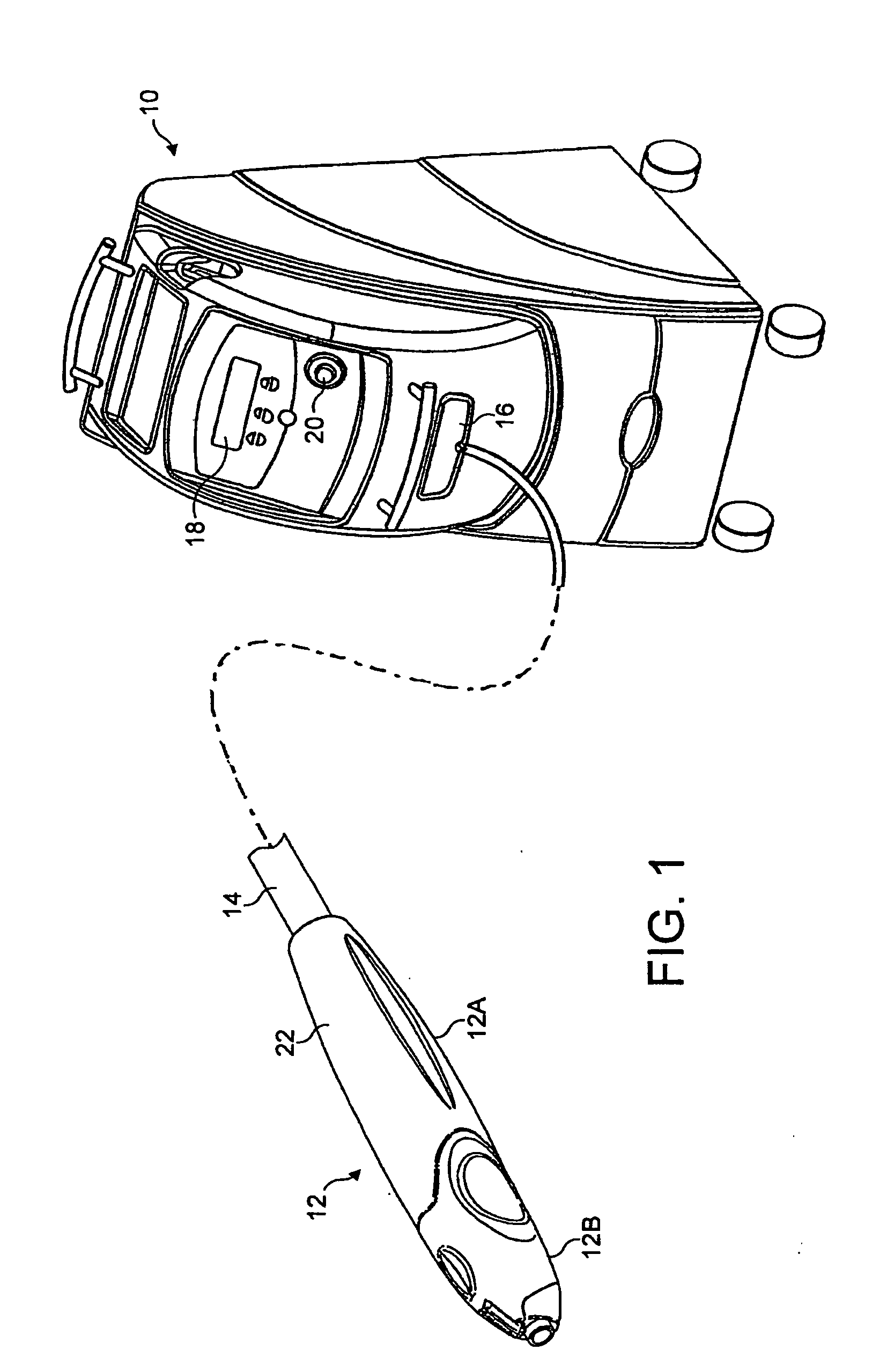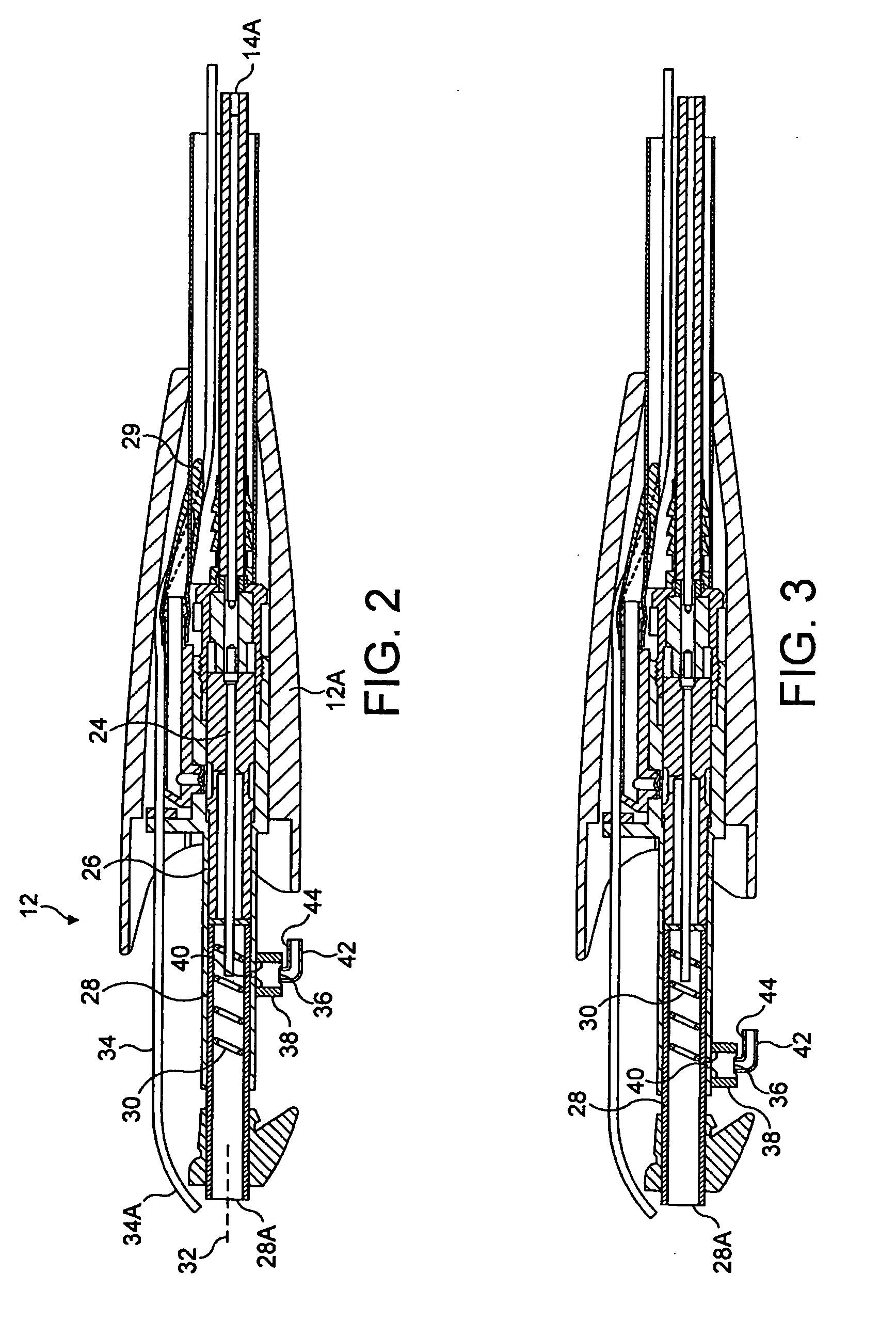Tissue treatment apparatus
a technology of tissue treatment and treatment apparatus, which is applied in the field of tissue treatment apparatus, can solve the problems of increasing the energy of the pulse, the tissue onto which the plasma is being directed, and the increase of the applied pulse duration
- Summary
- Abstract
- Description
- Claims
- Application Information
AI Technical Summary
Benefits of technology
Problems solved by technology
Method used
Image
Examples
first embodiment
[0039]In this first embodiment of the invention, an optical detector 36 is removably attached to an outer surface of the outer electrode 26 by means of a mounting member 38. The optical detector 36 is positioned such that it receives radiation from within the quartz tube 28 through a small aperture 40 in the surface of the outer electrode 26. The optical detector 36 is connected (a) to a power cable 42, the other end of which is connected to a power supply (not shown) to provide power to the optical detector, and (b) to a signal cable 44, the other end of which is connected to a central processing unit (CPU) (not shown) contained within the base unit 10. Any suitable optical detector 36 may be used, for example an integrated photo-optics sensor (model IPL 10530 DAL) made by Integrated Photo-Optics Limited. The aperture 40 is configured such that only a minimum amount of r.f. energy is leaked from within the quartz tube 28 whilst permitting adequate optical energy to reach the detect...
second embodiment
[0041]In the invention, as illustrated in FIG. 3, the optical detector 36 is removably connected, as before, to the surface of the outer electrode 26 by means of a mounting member 38, but is positioned at a distal end of the resonant coil 30. Radiation emitted from within the resonant coil 30 passes through a small aperture 40 and is detected by the optical detector 36, the output of which is fed to the CPU via signal cable 44. In this embodiment, the optical detector 36 views plasma that is forming and flowing within the resonant coil 30 and from the distal end of the inner electrode, before it reaches the exist nozzle 28A of the quartz tube 28.
third embodiment
[0042]In the present invention, as illustrated by FIG. 4, the optical detector 36 is removably connected to the exit nozzle 28A end of the quartz tube 28 by means of a mounting member 38. Since, in this embodiment, the optical detector 36 is positioned beyond the distal end of the outer conductor 26 and is attached directly to the quartz tube 28, which is substantially transparent, no aperture is required. As the plasma that is generated within the resonant coil 30 flows through the quartz tube 28, the quartz becomes hot. It is preferable, therefore, that the optical detector 36 is spaced from the surface of the quartz by means of a spacer (not shown), to avoid overheating, and possibly damaging, the optical detector.
[0043]In this embodiment, with the optical detector 36 positioned at the distal end of the quartz tube 28, the plasma radiation that is detected is substantially from the Lewis-Rayleigh afterglow. The quartz tube 28, and hence the mounting member 38, form part of the di...
PUM
 Login to View More
Login to View More Abstract
Description
Claims
Application Information
 Login to View More
Login to View More - R&D
- Intellectual Property
- Life Sciences
- Materials
- Tech Scout
- Unparalleled Data Quality
- Higher Quality Content
- 60% Fewer Hallucinations
Browse by: Latest US Patents, China's latest patents, Technical Efficacy Thesaurus, Application Domain, Technology Topic, Popular Technical Reports.
© 2025 PatSnap. All rights reserved.Legal|Privacy policy|Modern Slavery Act Transparency Statement|Sitemap|About US| Contact US: help@patsnap.com



